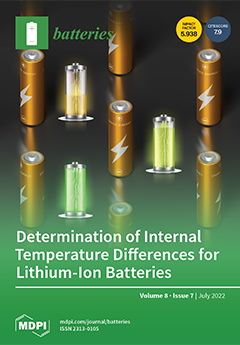Developing uniform ceramic-coated separators in high-energy Li secondary batteries has been a challenging task because aqueous ceramic coating slurries have poor dispersion stability and coating quality on the hydrophobic surfaces of polyolefin separators. In this study, we develop a simple but effective strategy for improving the dispersion stability of aqueous ceramic coating slurries by changing the mixing order of the ceramic slurry components. The aqueous ceramic coating slurry comprises ceramics (Al
2O
3), polymeric binders (sodium carboxymethyl cellulose, CMC), surfactants (disodium laureth sulfosuccinate, DLSS), and water. The interaction between the ceramic slurry components is studied by changing the mixing order of the ceramic slurry components and quantitatively evaluating the dispersion stability of the ceramic coating slurry using a Lumisizer. In the optimized mixing sequence, Al
2O
3 and DLSS premixed in aqueous Al
2O
3-DLSS micelles through strong surface interactions, and they repel each other due to steric repulsion. The addition of CMC in this state does not compromise the dispersion stability of aqueous ceramic coating slurries and enables uniform ceramic coating on polyethylene (PE) separators. The prepared Al
2O
3 ceramic-coated separators (Al
2O
3–CCSs) exhibit improved physical properties, such as high wettability electrolyte uptake and ionic conductivity, compared to the bare PE separators. Furthermore, Al
2O
3–CCSs exhibit improved electrochemical performance, such as rate capability and cycling performance. The half cells (LiMn
2O
4/Li metal) comprising Al
2O
3–CCSs retain 90.4% (88.4 mAh g
−1) of initial discharge capacity after 150 cycles, while 27.6% (26.4 mAh g
−1) for bare PE. Furthermore, the full cells (LiMn
2O
4/graphite) consisting of Al
2O
3–CCSs exhibit 69.8% (72.2 mAh g
−1) of the initial discharge capacity and 24.9% (25.0 mAh g
−1) for bare PE after 1150 cycles.
Full article





